Thanks Nick - this is truly appreciated.
You are using an out of date browser. It may not display this or other websites correctly.
You should upgrade or use an alternative browser.
You should upgrade or use an alternative browser.
Testing and evaluating CatLabs "X Film 320 Pro (2022 version)
-
A
- Thread starter aparat
- Start date
Recent Classifieds
-
Free FREE: Black Pentax Program Plus with electronic fault
- Started by Kodachromeguy
-
For Sale Deardorff 5x7 (V5) Camera with 4x5 Back & Toyo Film Holders
- Started by Barlow
-
For Sale Photo books
- Started by Doug Richardson
-
Sold Sekonic Auto-Leader L-188 Light Meter
- Started by Jon Shiu
Forum statistics
warden
Member
I noticed that too, but Catlabs sells directly to the consumer for less. The Catlabs film you shared there is the old version I think, rather than the "pro" version. They are easy to confuse.$8.99 vs $9.00?

CatLABS X Film 320 Black and White Negative Film (35mm Roll Film, 36 Exposures)
Buy CatLABS X Film 320 Black and White Negative Film (35mm Roll Film, 36 Exposures) featuring Panchromatic B&W Negative Film, ISO 320/26° in Standard Process, Fine Grain Structure, Wide Exposure Latitude and Tonal Range, Loaded in Plastic, Reusable Cassettes. Review CatLABS X Film 320www.bhphotovideo.com
warden
Member
But Catlabs already stated:
Yes, in most cases I place my trust with the manufacturer when it comes to processing decisions (at least as a starting point) but in this case there isn't enough information provided by Catlabs and the information provided lacks detail. I'd favor the analysis here at Photrio instead for this film.
But I still want a brave soul to expose this film at 1600 like they suggest on the Catlabs web site and see what happens. ;-)
Last edited:
Romanko
Member
Sorry, you are right, it must be the 2019 incarnation of X 320 on the B&H website.The Catlabs film you shared there is the old version
So, it is $8.99 for Ilford FP4+ vs. $6.99 for Catlabs X 320 Pro, then.
And Fomapan 100 Classic is $6.29.
Not comparing these films, just looking at prices.
Donald Qualls
Subscriber
$8.99 vs $9.00?
I paid about $6-$6.50 per roll for the ten roll pack I ordered direct from CatLabs. I have to presume and expect that B&H is taking a markup (not least to price in their "free" shipping).
faberryman
Subscriber
I paid about $6-$6.50 per roll for the ten roll pack I ordered direct from CatLabs. I have to presume and expect that B&H is taking a markup (not least to price in their "free" shipping).
Nope. The CatLABS film B&H lists as backordered is the rebranded Kodak 5222 CatLABS was selling a couple of years ago. CatLABS sold it for $9.00 on its site so B&H was selling it for the same price. B&H does not appear to be selling the new stuff.
aparat
Member
I have put together an example regarding the question of film speed in a typical film test. As @ic-racer in post #190 very nicely showed, the ISO method is very specific in how it establishes the parameters used to derive film speed. I think it's fair to say that a lot of photographers over the years have relied on that method to obtain excellent negatives. Having said that, there have been other methods of establishing film speed proposed over the years. Here, I took a Catlabs Pro 320 curve and calculated the speed point exposure and density by means of four different methods: (1) the ISO method (approx. ISO 64), (2) the Fractional CI method (Phil Davis, 1993) (approx. ISO 80), and (3) the Fractional Gradient method (approx. ISO 125), and (4) the Delta X method (approx. ISO 144). The argument in favor of virtually all of the proposed film speed methods over the years has been that they represent a more reasonable (or practical) estimate of film speed than the 0.1 criterion. As always, the goal of film speed testing is to offer a descriptive, rather than prescriptive, account of a film's response to exposure and development. At the end of the day, it's up to each photographer to decide how they expose and develop their film, so please take these results with a grain of salt.
Attachments
grat
Member
Fantastic. You are right. I just confirmed it by opening up the manual, which has been sitting on the shelf all along. So all I need is a RS-232 to serial cable plus a serial-to-USB adapter, yes? I owe you one. This is going to simplify things a lot. Thanks!
They actually make DB25 to USB serial cables.
pentaxuser
Member
Thanks Nick for all your work. I had only ever heard of Kodak's Contrast Index(C.I. ) and Ilford's G-bar and my impression is that those 2 are pretty close but in fact there are 4 with quite a spread of speeds which in this case is nearly a stop
Without wishing to stray from the reason for the thread I wonder, just as an idle musing, what the like of HP5+ or TMax 400 might be in the Delta X method? Maybe at least 650 or even 800?
pentaxuser
Without wishing to stray from the reason for the thread I wonder, just as an idle musing, what the like of HP5+ or TMax 400 might be in the Delta X method? Maybe at least 650 or even 800?

pentaxuser
aparat
Member
You bring up a very interesting point. There is a reason the 0.1 criterion has been so widely adopted by the photographic community over the decades, esp. by Zone System and BTZS photographers, as it allows one to produce consistent negatives with ample shadow detail and a very malleable family of curves that can be easily controlled with development (usually from N-2 to N+2). Lambrecht and Woodhouse (Way Beyond Monochrome, 2003) take it even further and suggest using Zone I.5 density or 0.17 above B+F as speed-point reference. This will allow even more shadow detail, at the (small) expense of film speed.Thanks Nick for all your work. I had only ever heard of Kodak's Contrast Index(C.I. ) and Ilford's G-bar and my impression is that those 2 are pretty close but in fact there are 4 with quite a spread of speeds which in this case is nearly a stop
Without wishing to stray from the reason for the thread I wonder, just as an idle musing, what the like of HP5+ or TMax 400 might be in the Delta X method? Maybe at least 650 or even 800?
pentaxuser
The reason why I decided to do the comparison between different speed-point methods was to offer some sort of data-based explanation for why some people are getting results they like by exposing the Catlabs film at EI 100 and EI 200. Those "old" criteria were based on print-judgment data, so there was an additional step involved, i.e., the creation of a "first acceptable" silver gelatin print, so there might have been be some loss of shadow detail. These days, it seems, most people, especially those that are the target demographic for Catlabs, scan film by DSLR, process in Negative Lab Pro + Lightroom, and share electronically, often forgoing printing altogether. Therefore, it does not seem unreasonable that they should be getting great photographs (esp. of the punchy or moody variety) with the Catlabs film in a hybrid process, even if they are sacrificing (some) shadow detail.
pentaxuser
Member
You bring up a very interesting point. There is a reason the 0.1 criterion has been so widely adopted by the photographic community over the decades, esp. by Zone System and BTZS photographers, as it allows one to produce consistent negatives with ample shadow detail and a very malleable family of curves that can be easily controlled with development (usually from N-2 to N+2). Lambrecht and Woodhouse (Way Beyond Monochrome, 2003) take it even further and suggest using Zone I.5 density or 0.17 above B+F as speed-point reference. This will allow even more shadow detail, at the (small) expense of film speed.
The reason why I decided to do the comparison between different speed-point methods was to offer some sort of data-based explanation for why some people are getting results they like by exposing the Catlabs film at EI 100 and EI 200. Those "old" criteria were based on print-judgment data, so there was an additional step involved, i.e., the creation of a "first acceptable" silver gelatin print, so there might have been be some loss of shadow detail. These days, it seems, most people, especially those that are the target demographic for Catlabs, scan film by DSLR, process in Negative Lab Pro + Lightroom, and share electronically, often forgoing printing altogether. Therefore, it does not seem unreasonable that they should be getting great photographs (esp. of the punchy or moody variety) with the Catlabs film in a hybrid process, even if they are sacrificing (some) shadow detail.
Thanks Nick I had thought of a witticism concerning punchy and moody but have decided not to express it

pentaxuser
bernard_L
Member
- Joined
- Feb 17, 2008
- Messages
- 2,089
- Format
- Multi Format
@ aparat, congratulations for your thorough work and clear presentation.
Back to the "paradox" of some people obtaining "OK" results at box (320) speed. Have a look at this testing of a mainstream film, HP5, there: https://carmencitafilmlab.com/blog/hp5-delta400/
scroll down halfway for a series of over (not our topic) and under-exposed pictures (click to enlarge)
Sure, the frame at -3 is a little washed out compared with the nominal exposure, but taken alone it is sort of OK. EI-320 -3stops is EI-40... And the people who shoot that new Catlab film at 320 do not bother to try exposing it 1, 2, or 3 stops more to see if it would improve the image quality.
I'm still puzzled that one can get away so easily with underexposure, but at least it seems to be nothing special with the Catlabs 320 film.
Back to the "paradox" of some people obtaining "OK" results at box (320) speed. Have a look at this testing of a mainstream film, HP5, there: https://carmencitafilmlab.com/blog/hp5-delta400/
scroll down halfway for a series of over (not our topic) and under-exposed pictures (click to enlarge)
Sure, the frame at -3 is a little washed out compared with the nominal exposure, but taken alone it is sort of OK. EI-320 -3stops is EI-40... And the people who shoot that new Catlab film at 320 do not bother to try exposing it 1, 2, or 3 stops more to see if it would improve the image quality.
I'm still puzzled that one can get away so easily with underexposure, but at least it seems to be nothing special with the Catlabs 320 film.
albada
Subscriber
The hump in the middle of the curves plotted by @aparat could be of use. The hump is an area of higher contrast. By controlling exposure, you could place the hump where you want. For example, expose at EI 320 and the hump will be in the light tones, giving you good contrast in the light zones, but shadows will quickly go black. That could create a good high-key photo. Or you could expose at EI 25 or 12, placing the hump in the shadow, creating a good low-key photo.
With normal films, you place an element on a zone. With CatLabs X 320 Pro, you place the hump on a zone. Hmm.
With normal films, you place an element on a zone. With CatLabs X 320 Pro, you place the hump on a zone. Hmm.
aparat
Member
Great examples! Thank you for posting the link.@ aparat, congratulations for your thorough work and clear presentation.
Back to the "paradox" of some people obtaining "OK" results at box (320) speed. Have a look at this testing of a mainstream film, HP5, there: https://carmencitafilmlab.com/blog/hp5-delta400/
scroll down halfway for a series of over (not our topic) and under-exposed pictures (click to enlarge)
Sure, the frame at -3 is a little washed out compared with the nominal exposure, but taken alone it is sort of OK. EI-320 -3stops is EI-40... And the people who shoot that new Catlab film at 320 do not bother to try exposing it 1, 2, or 3 stops more to see if it would improve the image quality.
I have found an illustration of how an underexposed negative can still produce pleasing results, in theory. Back in the 1950s and 1960s, there was some interesting research trying to determine what exactly makes a properly exposed negative, and to define all the formal parameters related to that (e.g., film speed, Average Gradient, Contrast Index, etc.). One of the key concepts was the first acceptable vs. first excellent exposure (as in, a negative that can be turned into a print). As I showed earlier (I am including the curve again here), the 0.1 criterion leads to better shadow detail, at the expense of film speed, whereas the Fractional Gradient (0.3G) method is more about getting the first "acceptable" negative, so you can sacrifice some shadow detail, but gain some speed. I suppose this distinction can, to some degree, account for the fact, as you very nicely point out, "one can get away so easily with underexposure." I think this is particularly true today, when scanners and/or DLSRs can get a lot of data out of a negative, and software can turn it into a very pleasing image.I'm still puzzled that one can get away so easily with underexposure, but at least it seems to be nothing special with the Catlabs 320 film.
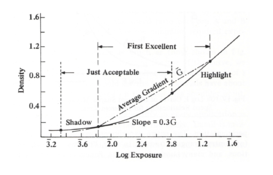

aparat
Member
I think it's potentially useful to see how the Catlabs Pro 320 compares to other popular films. I have already presented a comparison with Kodak 400TX and Arista Edu Ultra 100. Now, I have another popular film, Ilford FP4 Plus (fresh). I have used the very same exposure and developed the Ilford sample (in the same tank as the Catlabs Pro 320) for 8 minutes in Kodak D76 1+1 at 20C in a rotary processor. I think it makes most sense to compare curves of similar G, so the 5:45 min. Catlabs sample (Ḡ=0.6) and 8 min. Ilford sample (Ḡ=0.57) appear to be a good match. I then interpolated the curves to both have Ḡ=0.62, so we can make the comparison more meaningful. The dotted vertical lines in the last plot mark estimated speed points for Ilford FP4 Plus (2.39) and Catlabs Pro 320 (2.18) Relative Log Exposure.
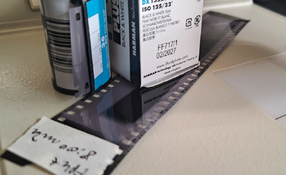
Ilford FP4 Plus turns out to be about 0.7 stops faster than Catlabs Pro 320. In my test, FP4 Plus has the estimated speed of around ISO 100+, which is close enough to the box speed of ISO 125 to be within the margin of error. It also has significantly higher B+F density (0.28). I think it is also interesting to compare the overall shapes of those two curves.
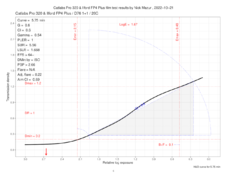
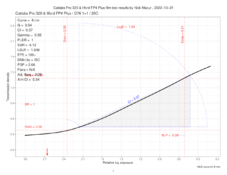
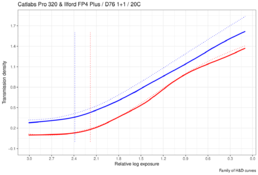

Ilford FP4 Plus turns out to be about 0.7 stops faster than Catlabs Pro 320. In my test, FP4 Plus has the estimated speed of around ISO 100+, which is close enough to the box speed of ISO 125 to be within the margin of error. It also has significantly higher B+F density (0.28). I think it is also interesting to compare the overall shapes of those two curves.



If wishes were horses...
I'd be interested in seeing a comparison with one of the "3200" films - Ilford Delta 3200, or Kodak TMax P3200.
I'd be interested in seeing a comparison with one of the "3200" films - Ilford Delta 3200, or Kodak TMax P3200.
Romanko
Member
It also has significantly higher B+F density (0.28).
This is interesting. The B+F level in Ilford technical data sheet is much lower than that:
The curve is for 8 min in ILFOTECH HC 1+31. The equivalent time in D76 1+1 would be 11 min.
Are you getting consistent F+B levels with the sensitometer and your DIY setup? It is probably best compared on faster films.
It would be interesting to compare your FP4+ curve with the Ilford data. They use relative log exposure so there's an arbitrary shift along the x-axis. PM me if you need help with plotting and analysis, I'd be more than happy to help.
Once again, thanks a lot for doing these experiments. You have achieved amazing results and I hope more are coming!
Romanko
Member
If wishes were horses...
I'd be interested in seeing a comparison with one of the "3200" films
Can we crowd-fund Nick? Buy him film and chemistry and whatever else he needs?
I would expect a film manufacturer to provide free samples (and a lot of assistance) for research like that but this is clearly not happening with Catlabs.
aparat
Member
This is interesting. The B+F level in Ilford technical data sheet is much lower than that:
View attachment 319628
The curve is for 8 min in ILFOTECH HC 1+31. The equivalent time in D76 1+1 would be 11 min.
Are you getting consistent F+B levels with the sensitometer and your DIY setup? It is probably best compared on faster films.
It would be interesting to compare your FP4+ curve with the Ilford data. They use relative log exposure so there's an arbitrary shift along the x-axis. PM me if you need help with plotting and analysis, I'd be more than happy to help.
Once again, thanks a lot for doing these experiments. You have achieved amazing results and I hope more are coming!
All great points! Yes, the 35 mm version of FP4 Plus has a much higher B+F density. This is true of many other Ilford and Kodak films. The graph you showed probably comes from 120 or sheet film. I typically get about 0.11 on 120 and 0.28 on 35 mm FP4 Plus. I have tried various developers and technique to get the B+F density as low as I can over the years, but now I only use D76 and Rodinal.
Presenting data with absolute log exposure values is coming next. I wanted to spread it out a bit, as there's a lot to unpack. I started pff by showing plots according to the BTZS / Win Plotter "mode" because that's what a lot of people are probably familiar with.
The relative vs. absolute exposure scale is an interesting topic in and of itself. Thank you so much for your offer to help! I will definitely take you up on that. My exposure was measured and controlled to the best of my ability, and, though it is consistent from trial to trial, I can only measure it with the tools I have so there's some inherent error there. I will talk more about this when I present the data in the next few days.
aparat
Member
If wishes were horses...
I'd be interested in seeing a comparison with one of the "3200" films - Ilford Delta 3200, or Kodak TMax P3200.
Yes. That would be interesting. I was going to get some Delta 3200, so I might as well get a couple of rolls of TMax 3200. I haven't used this new (is it new?) version yet.
aparat
Member
Can we crowd-fund Nick? Buy him film and chemistry and whatever else he needs?
I would expect a film manufacturer to provide free samples (and a lot of assistance) for research like that but this is clearly not happening with Catlabs.
That's awfully nice, but I already have all of the things I need, except film. I was curious about this film enough to take a deep dive. No worries

I might as well get a couple of rolls of TMax 3200. I haven't used this new (is it new?) version yet.
Re-introduced in 2018, after being discontinued in 2012.
Romanko
Member
You are correct, the curve is for roll film. Sorry, I overlooked this. 35 mm, type 120 and sheet film are coated on different bases, according to Ilford. That could explain different base levels.The graph you showed probably comes from 120 or sheet film.
aparat
Member
I don't know much about how film base differs across different products. Perhaps someone can chime in and explain the differences.You are correct, the curve is for roll film. Sorry, I overlooked this. 35 mm, type 120 and sheet film are coated on different bases, according to Ilford. That could explain different base levels.
faberryman
Subscriber
So here's a question about black and white film processing of oddball films like the CatLABS. If a film processor gets it in, does he go to the internet to get developer recommendations. What happens if the recommended development time doesn't match up with the times he uses for standard films? Does he process it separately in a small tank? Does he run it through the dip and dunk machinery all by itself?
| Photrio.com contains affiliate links to products. We may receive a commission for purchases made through these links. To read our full affiliate disclosure statement please click Here. |
PHOTRIO PARTNERS EQUALLY FUNDING OUR COMMUNITY:  |




